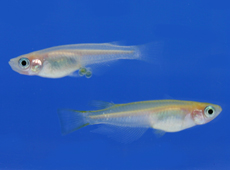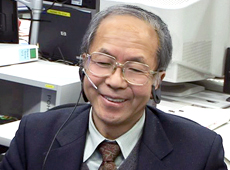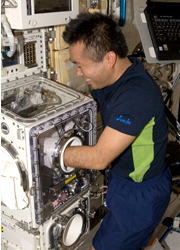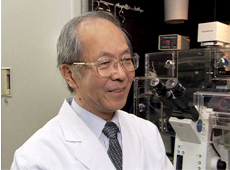Q. What kind of life science experiments do you want to perform in Kibo in the future?

Rice fish from the group grown for use in space experiments. (Courtesy: University of Tokyo)
I’d like to study how many generations it takes for rice fish to alter, how these changes work, and how the fish’s behaviour changes. Rice fish grow very quickly - they go from roe to adult fish that can spawn in about three months. So during a long-term ISS expedition, astronauts can observe two or even three generations. The rice fish’s body is see-through, so we can observe not only how they swim, but also their circulatory system and cardiac muscles.
Rice fish are very familiar living organisms to the Japanese, and research on them has a very long history. I’d like to use these fish to perform unique research, originated in Japan. The rice fish genome is completely decoded, and we know that there are some genes similar to those of humans. Thus, when humanity aims to travel to the Moon and Mars in the future, this research could give us very important data.
Research professor at the University of Tokyo, Director of the Research Center for Stem Cell Engineering at the National Institute of Advanced Industrial Science and Technology
Dr. Asashima completed his Ph.D. in science at the University of Tokyo in 1972. After working as a researcher at the Institute of Biology of the Free University of Berlin in Germany, and as a professor at the Faculty of Liberal Arts and Sciences, Yokohama City University, he became a professor at the College of Arts and Sciences, University of Tokyo, in 1993. He was posted as a professor of the University of Tokyo Graduate School of Arts and Sciences in 1996, and became Dean there in 2003. In 2005, Dr. Asashima became a vice president of the Science Council of Japan. In 2006, he became a laboratory administrator at the Organ Development Engineering Research Institute, National Institute of Advanced Industrial Science and Technology (AIST). He was Associate Dean and a member of the board of directors at the University of Tokyo in 2007-08. In 2009 he became a senior fellow at the Center for Research and Development Strategy of the Japan Science and Technology Agency, and rose to his current position, as a director at the Research Center for Stem Cell Engineering at AIST in April 2010.
In 1989, Dr. Asashima discovered the protein activin, which induces cell differentiation. Subsequently, he created 22 organs, such as the heart and kidney, opening the door to regenerative medicine. He has received many awards, including the Zoological Science Award in 1990, the Franz von Siebold Award from the German government in 1994, the Japanese Medal of Honor in 2001, the Imperial and Japan Academy Prizes, and the Erwin Stein Award in 2008. In 2008, he was selected by the Japanese Ministry of Education, Culture, Sports, Science and Technology as an individual who has made outstanding cultural contributions. His specializes in developmental biology.
"I think living creatures are works of art."
Enhancing Quality of Life through Deep Understanding of Protein Structure
Space Medicine: Ultimate Preventive Medicine for Human Space Flight
The X-ray Observatory to Make the Violent Universe Visible


